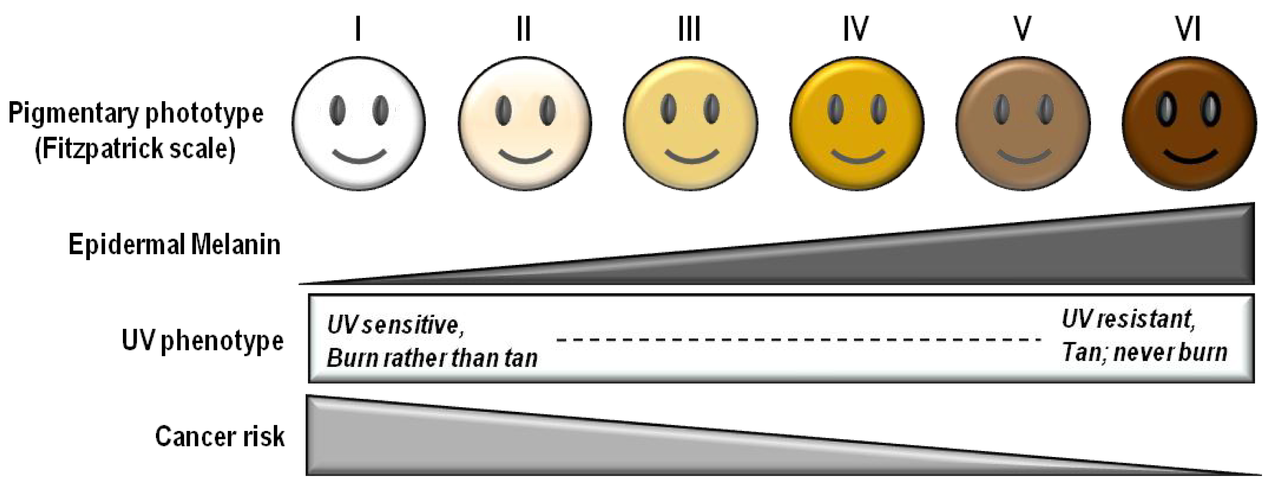Fitzpatrick scale on:
[Wikipedia]
[Google]
[Amazon]
 The Fitzpatrick scale (also Fitzpatrick skin typing test; or Fitzpatrick phototyping scale) is a numerical classification schema for
The Fitzpatrick scale (also Fitzpatrick skin typing test; or Fitzpatrick phototyping scale) is a numerical classification schema for
 The Fitzpatrick scale (also Fitzpatrick skin typing test; or Fitzpatrick phototyping scale) is a numerical classification schema for
The Fitzpatrick scale (also Fitzpatrick skin typing test; or Fitzpatrick phototyping scale) is a numerical classification schema for human skin color
Human skin color ranges from the darkest brown to the lightest hues. Differences in skin color among individuals is caused by variation in pigmentation, which is the result of genetics (inherited from one's biological parents and or indiv ...
. It was developed in 1975 by American dermatologist Thomas B. Fitzpatrick
Thomas B. Fitzpatrick (December 19, 1919 – November 16, 2003) was an American dermatologist. He was Chairman of the Department of Dermatology at Harvard Medical School and Chief of the Massachusetts General Hospital Dermatology Service from 195 ...
as a way to estimate the response of different types of skin to ultraviolet
Ultraviolet (UV) is a form of electromagnetic radiation with wavelength from 10 nm (with a corresponding frequency around 30 PHz) to 400 nm (750 THz), shorter than that of visible light, but longer than X-rays. UV radiation ...
(UV) light.Fitzpatrick, T. B. (1975). "Soleil et peau" un and skin
The United Nations (UN) is an intergovernmental organization whose stated purposes are to maintain international peace and security, develop friendly relations among nations, achieve international cooperation, and be a centre for harmonizin ...
''Journal de Médecine Esthétique'' (in French) (2): 33–34 It was initially developed on the basis of skin color to measure the correct dose of UVA for PUVA therapy
PUVA (psoralen and UVA) is an ultraviolet light therapy treatment for skin diseases: eczema, psoriasis, graft-versus-host disease, vitiligo, mycosis fungoides, large plaque parapsoriasis, and cutaneous T-cell lymphoma, using the sensitizing e ...
, and when the initial testing based only on hair and eye colour resulted in too high UVA doses for some, it was altered to be based on the patient's reports of how their skin responds to the sun; it was also extended to a wider range of skin types.Pathak, M. A.; Jimbow, K.; Szabo, G.; Fitzpatrick, T. B. (1976). "Sunlight and melanin pigmentation". In Smith, K. C. (ed.): ''Photochemical and photobiological reviews'', Plenum Press, New York. pp. 211–39Fitzpatrick, T. B. (1986). "Ultraviolet-induced pigmentary changes: Benefits and hazards", ''Therapeutic Photomedicine'', Karger, vol. 15 of "Current Problems in Dermatology", pp. 25–38 The Fitzpatrick scale remains a recognized tool for dermatological research into human skin pigmentation.
The following list shows the six categories of the Fitzpatrick scale in relation to the 36 categories of the older von Luschan scale (in parenthesis):
* Type I (scores 0–6) always burns, never tans (palest; freckles)
* Type II (scores 7–13) usually burns, tans minimally (light colored but darker than fair)
* Type III (scores 14–20) sometimes mild burn, tans uniformly (golden honey or olive)
* Type IV (scores 21–27) burns minimally, always tans well (moderate brown)
* Type V (scores 28–34) very rarely burns, tans very easily (dark brown)
* Type VI (scores 35–36) never burns (deeply pigmented dark brown to darkest brown)
Emoji modifiers
The Fitzpatrick scale is also the basis of skin color inemoji
An emoji ( ; plural emoji or emojis) is a pictogram, logogram, ideogram or smiley embedded in text and used in electronic messages and web pages. The primary function of emoji is to fill in emotional cues otherwise missing from typed conv ...
, with five modifiers according to the Fitzpatrick scale (types and merged).
See also
*von Luschan's chromatic scale
Von Luschan's chromatic scale (VLS) is a method of classifying skin color. It is also called the von Luschan scale or von Luschan's scale. It is named after its inventor, Felix von Luschan. The equipment consists of 36 opaque glass tiles whic ...
* Skin reflectance
* Brown Paper Bag Test
"The Brown Paper Bag Test" is a term in African-American oral history used to describe a colorist discriminatory practice within the African-American community in the 20th century, in which an individual's skin tone is compared to the color of a ...
References
{{Skin colors Dermatologic terminology Skin pigmentation 1975 introductions Color scales